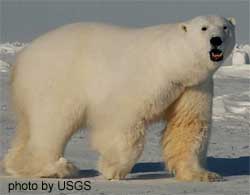Nunavut health officials reported on a trichinosis case in a resident of Sanikiluaq, prompting a health warning for that community.

Trichinosis is an infection often caused by eating the roundworm in raw or undercooked polar bear meat.
Health officials say if you have eaten any uncooked polar bear recently and are experiencing stomach pain, muscle pain, diarrhea, swollen eyelids, sweating and weakness, you might be infected with trichinella and should go to the health centre.
Since trichinella cannot be killed by freezing, polar bear meat should be cooked until there is no pink or red left in the meat.
Trichinosis is a parasitic disease caused most commonly by the roundworm Trichinella spiralis. If someone ingests undercooked or raw meat with the encysted larvae, the stomach acid releases the larvae which mature to adults in the intestine.
After about a week the female starts releasing larvae which enter the bloodstream and find their way to skeletal muscle where they encapsulate.
There can be gastrointestinal symptoms mimicking acute food poisoning when there is activity of the adults in the intestine.
Sudden appearance of fever, muscle soreness and pain with swelling of parts of the face is early classic signs. This can sometimes be followed by retinal hemorrhages and other ocular signs.
With heavy infections cardiac, respiratory and neurological problems may ensue with death by heart failure being most common. The more larvae you ingest, the more serious the disease.
In the Arctic, trichinellosis, or trichinosis, is caused by a microscopic parasite called Trichinella nativa, sometimes found in the meat of wild mammals like polar bears, black bears, wolves, foxes and, most commonly, walruses.
The Parasitology interviews, Part 1
The Parasitology interviews, Part 2
The Parasitology interviews, Part 3

